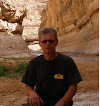Day 450
50,583 km since the beginning of the journey
Last week route: Windhoek, Walvis Bay - Swakopmund.
Written in Swakopmund, which is small and like a genuine German town by the Atlantic Ocean in Namibia.

Hohenzollen House – a hotel - built in 1906

Sunset. Swakopmund Jetty or pier. The first wooden pier – the length is 275 meters and width 9 meters - was built in 1905. The construction of the metal pier began in 1911 and the length of the bridge was planned to be 640 meters, but when the I World War began - only 262 meters were completed and after the war it was decided to use Walwis Bay, that was 30 kilometers away, as a port. Today the bridge is restored and was reopened in 2010.

The lighthouse - built in 1903.

While entering the city there is another interesting road sign. I stop and make a picture.

Woermann House



Here is the world's largest quartz crystal

14 tons or to be more precise - 14,100 kg

The Living Desert Snake Park was able to surprise as well, because inside a glass box there were...

....Albino pythons.

A few days ago I drove 120 kilometres along the coastal road upwards to Cape Cross to visit the colony of seals.

Self-service counter with salt crystals by the road. You just can choose the piece you like and leave the money into the can.

There are stores for wealthier tourists. The poorer ones can make a stop by the road side and try to get by themselves some pieces from the salt lake. Provided, of course, that they have the tools, namely a hammer and chisel.


The seal colony in Cape Cross, there were supposed to be 80-100 thousand animals.

Quite possible as there were so many of them, everywhere, even in the guest area.

Under the benches









Only the weather was foggy, and the existence of the sun could only be assumed - so all the images turned out seal-gray.

Cape Cross is named after the stone cross or padrão – that was set up here by the Portuguese navigator Diego Cao in 1486, here was the southernmost point of his second voyage.

Zeila of Hangana. The fishing vessel, which was sold as ferrous scrap, and then an attempt was made to transport it from the port of Walwis Bay to Bombay, India, with the help of the ropes , but the ropes broke and the ship ran ashore on 25 August, 2008. It has now become one of the attractions of Henties Bay.
The next morning inspecting my car - coated with salt and other sticky stuff - I decided to drive to the carwash – the main issue was to get the bottom of the car clean from the salt. Life has taught that the car cannot last the next 25 years so easily when accompanied by salt for a longer time.

And so the laundry was performed. The car wheel arches and bottom became clean, and then on to the (hand) drying. And an hour later along the dusty road into the desert. So much about the clean car.

To be more precise – to the Namib-Naukluff Park, as there are two more attractions to look over near Swakopmund - at first to "Moon Landscape", and further on the road leads to a region where the ultra-rare desert plant 'Welwitschia mirabilis' is growing.
When driving out of town there is Martin Luther Museum by the road. But not that Martin Luther, whose name and views are familiar to us through the Reformation.

There is a steam-engine tractor – named Martin Luther – with an interesting history at the museum.

In 1890s the trade between Swakopmund, located by the ocean, and the capital Windhoek - 382 km away from Swakopmund and located in the inland Windhoek, was started by the means of ox - transport. Up to 2 tons of goods could be loaded on the wagon and it was dragged by 14 to 20 oxen. The journey lasted about 2-3 weeks, and in the end of the trip the survivors of the oxen were in such a poor condition that it took them three months to recover.
In 1896 a tractor was brought under the control of the British to the port of Walvis Bay, as there was no deep port in Wakopmund. A driver-mechanic, who had come with the vehicle, reacted, as described, in the following way - "The Mechanic took one look at the desert and went home".
Next - the tractor had to be moved to Swakopmund. The distance between the two cities was 30 kilometres, but it took 3 months to complete the task (!), because instead of moving on in the sand it sank in up to the axles and so stones and wooden boards were placed under the wheels. And basically it was pushed to Swakopmund. Link
Later it turned out that the tractor was more costly than the use of the oxen. Next - two machines of gasoline motors were imported, one of them made a successful tour to Windhoek, the load being about were 20 tons. The Last wagon was equipped with a brake system, which was “the sand – anchor”.
The tractor was used up until 1897, and after its boiler had exploded, was left on the roadside about 1,5 km away from Swakopmund. And this machine was called “Martin Luther” due to the sentence "Here I stand and I cannot do otherwise” by Martin Luther. In fact-the sentence was rather different

The tractor was restored in 1973 and is a National Monument of Namibia.

Over the moon-land to visit Welwitschia


And then the first Welwitschia Plants appeared on the roadside.

But more about them in the next post.



No comments:
Post a Comment